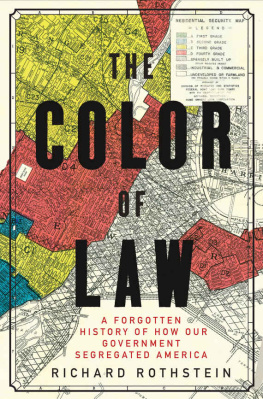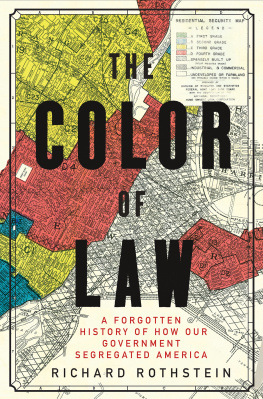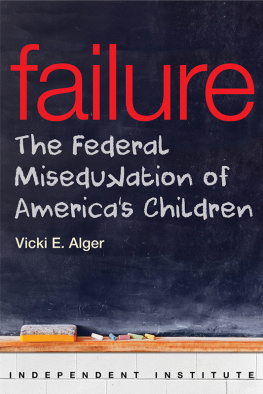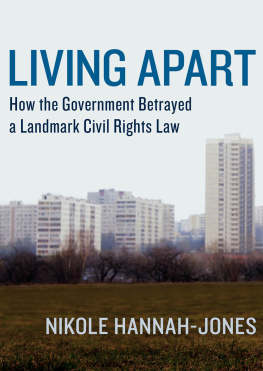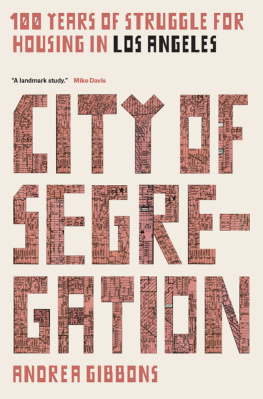Richard Rothstein - The Color of Law: A Forgotten History of How Our Government Segregated America
Here you can read online Richard Rothstein - The Color of Law: A Forgotten History of How Our Government Segregated America full text of the book (entire story) in english for free. Download pdf and epub, get meaning, cover and reviews about this ebook. year: 2017, publisher: Liveright, genre: Politics. Description of the work, (preface) as well as reviews are available. Best literature library LitArk.com created for fans of good reading and offers a wide selection of genres:
Romance novel
Science fiction
Adventure
Detective
Science
History
Home and family
Prose
Art
Politics
Computer
Non-fiction
Religion
Business
Children
Humor
Choose a favorite category and find really read worthwhile books. Enjoy immersion in the world of imagination, feel the emotions of the characters or learn something new for yourself, make an fascinating discovery.
- Book:The Color of Law: A Forgotten History of How Our Government Segregated America
- Author:
- Publisher:Liveright
- Genre:
- Year:2017
- Rating:3 / 5
- Favourites:Add to favourites
- Your mark:
The Color of Law: A Forgotten History of How Our Government Segregated America: summary, description and annotation
We offer to read an annotation, description, summary or preface (depends on what the author of the book "The Color of Law: A Forgotten History of How Our Government Segregated America" wrote himself). If you haven't found the necessary information about the book — write in the comments, we will try to find it.
A Publishers Weekly Top 10 Best Books of 2017
Long-listed for the National Book Award
Rothstein has presented what I consider to be the most forceful argument ever published on how federal, state, and local governments gave rise to and reinforced neighborhood segregation. William Julius Wilson
In this groundbreaking history of the modern American metropolis, Richard Rothstein, a leading authority on housing policy, explodes the myth that Americas cities came to be racially divided through de facto segregationthat is, through individual prejudices, income differences, or the actions of private institutions like banks and real estate agencies. Rather, The Color of Law incontrovertibly makes clear that it was de jure segregationthe laws and policy decisions passed by local, state, and federal governmentsthat actually promoted the discriminatory patterns that continue to this day.
Through extraordinary revelations and extensive research that Ta-Nehisi Coates has lauded as brilliant (The Atlantic), Rothstein comes to chronicle nothing less than an untold story that begins in the 1920s, showing how this process of de jure segregation began with explicit racial zoning, as millions of African Americans moved in a great historical migration from the south to the north.
As Jane Jacobs established in her classic The Death and Life of Great American Cities, it was the deeply flawed urban planning of the 1950s that created many of the impoverished neighborhoods we know. Now, Rothstein expands our understanding of this history, showing how government policies led to the creation of officially segregated public housing and the demolition of previously integrated neighborhoods. While urban areas rapidly deteriorated, the great American suburbanization of the postWorld War II years was spurred on by federal subsidies for builders on the condition that no homes be sold to African Americans. Finally, Rothstein shows how police and prosecutors brutally upheld these standards by supporting violent resistance to black families in white neighborhoods.
The Fair Housing Act of 1968 prohibited future discrimination but did nothing to reverse residential patterns that had become deeply embedded. Yet recent outbursts of violence in cities like Baltimore, Ferguson, and Minneapolis show us precisely how the legacy of these earlier eras contributes to persistent racial unrest. The American landscape will never look the same to readers of this important book (Sherrilyn Ifill, president of the NAACP Legal Defense Fund), as Rothsteins invaluable examination shows that only by relearning this history can we finally pave the way for the nation to remedy its unconstitutional past.
13 illustrationsRichard Rothstein: author's other books
Who wrote The Color of Law: A Forgotten History of How Our Government Segregated America? Find out the surname, the name of the author of the book and a list of all author's works by series.

